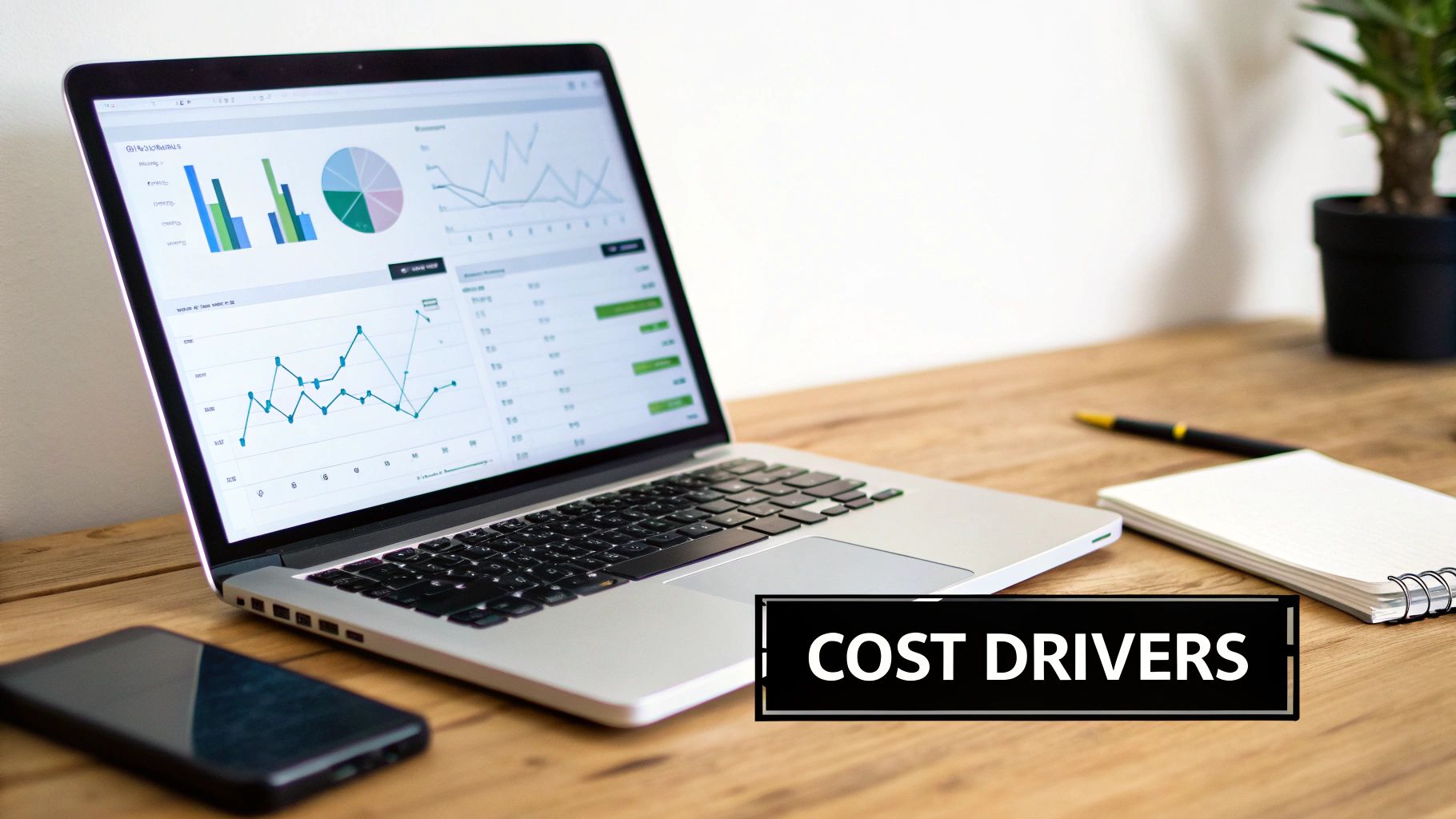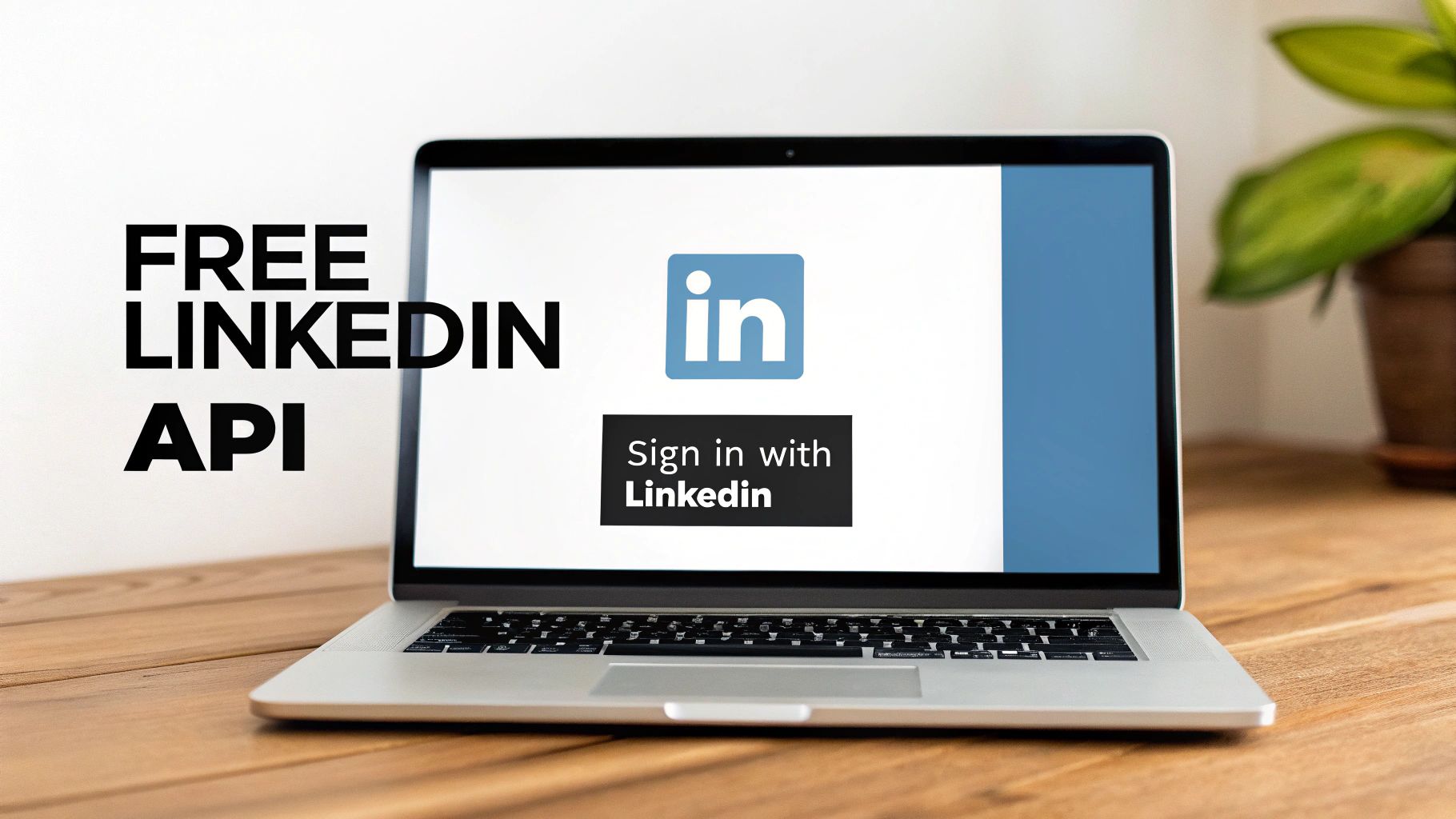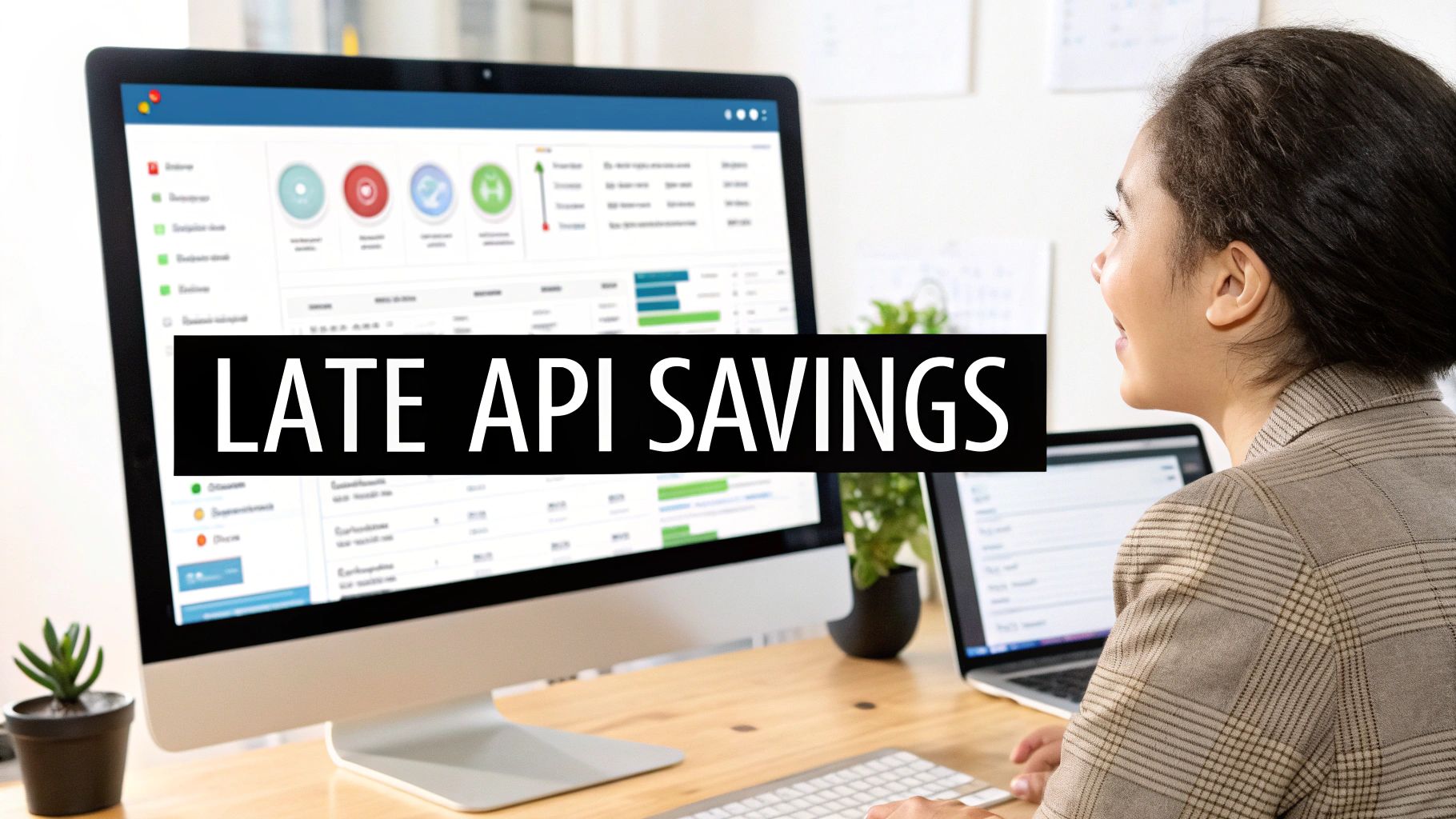Trying to pin down a straightforward price for the LinkedIn API is a common point of confusion. The short answer? There isn't one. At least, not a public price list you can just look up for most business needs.
While LinkedIn does offer a free, limited API for basic tasks like letting users sign in with their profile, the real power lies behind their exclusive Partner Program. For anything more advanced, pricing is custom-negotiated for every single applicant.
Understanding LinkedIn API Access Tiers
Getting access to LinkedIn's massive professional dataset isn't as simple as swiping a credit card. LinkedIn is extremely protective of its user data and the quality of its platform, so it uses a tiered system to manage who gets access and how. This approach separates the basic, foundational functionalities from the powerful, enterprise-grade tools.
Think of it as two distinct paths. One path lets developers experiment with basic integrations for free. The other is a much more rigorous process designed for commercial applications that need deep, reliable access to LinkedIn's ecosystem.
This strict control is also a big reason why the pricing is so customized—it helps ensure every partner complies with privacy rules like GDPR. If your goal is a simple "Sign in with LinkedIn" button, the free tier has you covered. But if you need to tap into the Sales Navigator, Recruiter, or Marketing APIs, you’ll have to become an approved partner and work out a custom deal based on your data volume, how you plan to use it, and your partner status.
The two main routes for API access are pretty clear-cut.

This distinction is important: free access is for limited, foundational features, while the Partner Program is the only real gateway for scalable, commercial integrations. For any serious business application, the journey almost always starts with a partnership application.
LinkedIn API Tiers and Pricing Models
To make this a bit clearer, here's a quick breakdown of the available tiers, what they're for, and how they're generally priced.
| API Tier | Primary Use Case | Typical Pricing Model | Access Requirements |
|---|---|---|---|
| Free Tier (Products) | Basic user authentication (e.g., "Sign in with LinkedIn"), sharing content to LinkedIn. | Free | Publicly available with a developer application and standard rate limits. |
| Partner Program (Marketing, Sales, etc.) | Deep integrations for advertising, recruiting, sales intelligence, and learning platforms. | Custom / Negotiated | Requires a formal application, business vetting, and a contractual agreement. |
| Third-Party Aggregators | Accessing LinkedIn data through a certified partner tool (e.g., a social media scheduler). | Subscription-Based | Pay the third-party provider's subscription fee; no direct LinkedIn negotiation. |
This table shows that while "free" access exists, it's very narrow. The real value for businesses is unlocked through partnership or by using an existing partner's tool, both of which come with their own costs.
The Official LinkedIn Partner Program Explained
If you need more than just basic authentication, your only real path forward is the official LinkedIn Partner Program. Don't think of this as a simple sign-up form; it's an exclusive, application-based system designed to put potential partners under a microscope. LinkedIn is fiercely protective of its platform's integrity and the privacy of its over 1 billion members, so this vetting process is no joke.
When you apply, you'll need to submit a detailed proposal that makes a strong case for your business. You have to explain exactly how you plan to use their data and, crucially, how your application will actually benefit LinkedIn users. They are incredibly selective and tend to approve established companies with a clear, strategic purpose that fits neatly into their ecosystem. If you're a startup or building an app with a vague use case, getting approved will be a tough climb.
Partner Tracks and API Access
Once you're in the application process, you have to pick a specific partner "track." This choice is a big deal—it dictates which API endpoints you can access and heavily influences the final LinkedIn API pricing you'll negotiate. Each track is built for a very specific business function.
The main partner tracks you'll encounter are:
- Marketing Developer Program: This is for anyone building advertising tools, campaign management software, or analytics dashboards.
- Talent Solutions Partner Program: Aimed squarely at recruiting platforms, applicant tracking systems (ATS), and other HR software.
- Sales Developer Program: Designed for CRM integrations and sales intelligence tools that need to plug into Sales Navigator.
Choosing the right track is critical. For instance, if you submit an application for a marketing tool but ask for access to recruiting data, your request will almost certainly be rejected. The mismatch in purpose is an immediate red flag.
This structured approach makes sure partners only get their hands on data relevant to what they say they're doing. It prevents data misuse and keeps the value of LinkedIn’s professional dataset high. From there, the final cost is hammered out in negotiations based on your chosen track, the volume of data you need, and the commercial scale of your application.
Key Factors That Determine Your API Costs
Since LinkedIn’s premium APIs are priced on a custom quote basis, you really need to understand the variables that will shape your final bill. The LinkedIn API pricing you get isn't just a number pulled out of a hat; it’s a calculated figure based on your application's scale, scope, and how you plan to use their data commercially.
Going into negotiations without a solid grasp of these cost drivers is a recipe for a bad deal. If you know what they're looking at, you can put together a much better estimate of your potential investment and build a stronger business case for your project.
Application Scale and Data Volume
The single biggest factor in your API cost is the sheer volume of data you plan to pull and push. LinkedIn looks at how intensely you'll be using their system. An app making thousands of API calls a day is obviously going to cost more than one making a few hundred.
Here are the key metrics they’ll be looking at:
- API Call Volume: The total number of requests your application will make, whether it's daily or monthly.
- Number of Connected Accounts: How many end-user or company accounts will your app be managing? A CRM built for 10,000 users is a totally different beast than an internal tool for a 10-person team.
- Specific Endpoints: Not all data is created equal. Accessing high-value endpoints, like detailed profiles from Sales Navigator, will cost you a lot more than pulling basic company page information.
For instance, a marketing analytics platform that needs to grab ad performance data for hundreds of clients is going to see a much higher price tag than a simple app that just syncs profile updates for a small internal team.
Commercial Use Case and Development Costs
LinkedIn also carefully evaluates the commercial nature of your application. An app you're selling to enterprise customers is seen as a higher-value integration compared to an internal tool that just improves productivity. Ever since Microsoft bought LinkedIn for $26.2 billion back in 2016, the platform has been laser-focused on monetizing its data, and it's working—revenues now top $15 billion.
Their pricing often scales with your usage, and it's not uncommon to see plans that charge monthly fees from $49 to $99 per seat.
Of course, the direct API fees are only part of the story. You also have to factor in your development expenses. Integrating any API requires skilled developers, whether you have them in-house or need to outsource the work. For a good breakdown of managing external teams, this guide on understanding offshore software development costs is a fantastic resource.
If you’re looking for simpler, more transparent pricing, it might be worth exploring what other social media APIs cost. You can check out our guide on social media API pricing to see how different platforms stack up.
How to Use LinkedIn APIs for Free
While a lot of the high-value data requires getting into the Partner Program (and the negotiated price tag that comes with it), you don't always need a formal partnership to use LinkedIn's developer tools. Thankfully, LinkedIn offers a free tier through its standard developer program. It's a direct and accessible path for smaller projects and startups looking to add some basic LinkedIn functionality.
This free access really boils down to two key products: Sign In with LinkedIn and a stripped-down version of the Profile API. These are perfect for apps that need to verify a user's identity or pull basic, user-approved profile info. Just be aware that they come with pretty strict rate limits, which are there to manage server load and prevent anyone from abusing the system.

Common Use Cases for Free APIs
The practical uses for these free endpoints are pretty straightforward but still incredibly valuable.
- User Authentication: The most common application is simply adding a "Sign In with LinkedIn" button to your website or app. This lets users register using their existing professional profile, which is often much faster and more convenient for them.
- Profile Enrichment: Once a user gives their consent, your application can grab their name, profile picture, and headline. This is a great way to create a more personalized experience right from the get-go.
If you're looking for clever, low-cost ways to manage these kinds of API interactions, checking in with n8n consultants can be a smart move. They specialize in building out efficient automation workflows that won't break the bank.
The critical thing to remember here is that these APIs are entirely consent-based. You can't access any user data until they have explicitly given your app permission through the standard OAuth 2.0 flow.
And if you're curious about how this compares to other platforms, our guide on how social media APIs can be free gives a broader view of the landscape.
Alternatives to the Official LinkedIn API
Let's be honest: navigating the high costs and strict rules of LinkedIn's official Partner Program can feel like hitting a brick wall. This reality has opened the door for third-party services that offer a different way to access LinkedIn data—often a much more affordable and straightforward path for businesses that just don't qualify for a direct partnership.
These providers typically work by collecting public LinkedIn data or by offering a unified API that simplifies access. They then package this functionality and offer it through their own APIs, saving you the headache of negotiating directly with LinkedIn. It’s a completely different approach to LinkedIn API pricing, swapping out opaque custom quotes for clear, predictable models.

How Late API Offers a Cost-Effective Solution
Trying to get into LinkedIn’s official Partner Program is a major roadblock for many developers. This is exactly where an alternative like Late API comes in, offering a practical and much more affordable way to integrate with LinkedIn.
Late API bypasses the usual headaches associated with LinkedIn API pricing and access. Instead of a drawn-out approval process, you get a unified API for LinkedIn and other major social platforms right away. This means you can start scheduling posts or automating your content workflow immediately, without being locked into a massive, enterprise-level contract. It's the perfect fit if you just need reliable LinkedIn integration without the corporate overhead.
With a simple, transparent subscription model and a developer-first approach, you get access to core functionalities like:
- Automated Content Scheduling: Programmatically queue up posts for your LinkedIn company page or personal profile.
- Centralized Media Management: A single endpoint to handle all your images and videos for your posts.
- Cross-Platform Distribution: Push content to LinkedIn and your other social networks from one place.
This model gives you the essential tools you need without the hefty price tag. For a closer look at what's possible, check out our guide on finding the perfect scheduling tool for LinkedIn.
Other Third-Party Providers and Data Scrapers
Beyond unified APIs like Late, other third-party providers specialize in different areas. Some offer:
- Profile Enrichment APIs: These are great for taking a simple piece of contact info, like an email, and fleshing it out with a full professional profile.
- Company Data APIs: Perfect for gathering firmographic data—think company size, industry, and location.
- Lead Generation Tools: These platforms let you search and filter LinkedIn’s massive database to build highly targeted lead lists.
The pricing for these services is refreshingly simple. For instance, some providers offer monthly plans starting as low as $49. If you just need a one-off data pull, you might find a large dataset for around $250 for 100,000 records. For continuous data access, subscription APIs can start from about $1,200 per month. It's worth exploring the different pricing models to see how they stack up.
Of course, it's not without its trade-offs. While you get better accessibility and much lower costs, you have to consider potential risks. Things like data freshness and whether the service complies with LinkedIn's terms of service are big ones. Always do your homework and carefully vet how a provider sources its data before you commit.
LinkedIn API Pricing: Your Questions Answered
Trying to get a straight answer on LinkedIn API pricing can feel like navigating a maze. I get it. Let’s cut through the noise and tackle the most common questions developers and businesses have before they dive in.

Is There a Free LinkedIn API?
Yes, but it's very limited. LinkedIn offers a basic, free API that’s really only good for two things: user authentication ("Sign In with LinkedIn") and pulling a small slice of a user's profile data. And even then, you only get that data after the user explicitly gives you permission.
Its scope is intentionally narrow and comes with some pretty tight rate limits. If you need anything more substantial for marketing, sales, or recruiting, you'll have to apply for the official LinkedIn Partner Program, which is a whole different ballgame with custom pricing.
How Much Does the LinkedIn Marketing API Cost?
This is the million-dollar question, and unfortunately, there's no public price tag. Access to the LinkedIn Marketing API is granted exclusively through their Partner Program, and pricing is negotiated on a case-by-case basis.
The final cost really depends on your specific needs. They’ll look at things like:
- What you’re building and your end goal.
- How many ad accounts you plan to manage.
- Your estimated API call volume (daily and monthly).
- The specific endpoints and data points you need to access.
Think of it as an enterprise-level solution—it's built for established marketing platforms, not small-scale projects.
Can I Get LinkedIn API Access Without Being a Partner?
Directly? No. Access to LinkedIn's more powerful, data-rich APIs is gated behind the official Partner Program. If you don't qualify or get approved, you're out of luck with them.
However, that doesn't mean you have no options. You can work with third-party, unified API providers like Late. These services act as an intermediary, offering their own platforms with clear, transparent pricing models. For many businesses, this route is far more accessible and often more affordable.
What Are the Risks of Using Unofficial APIs?
While third-party APIs can be a great, cost-effective alternative, you need to go in with your eyes open. The biggest risk is a potential violation of LinkedIn’s terms of service, which could lead to trouble down the road.
Another thing to watch for is data quality. Some unofficial providers might rely on data scraping, which means the information you get could be inaccurate or outdated. It's absolutely crucial to pick a reputable provider, ask tough questions about how they source their data, and make sure they’re fully compliant with privacy laws like GDPR and CCPA.
Tired of wrestling with complex, individual social media APIs? Late simplifies everything by giving you a single, unified API for LinkedIn and nine other major platforms. Start building faster and smarter today at https://getlate.dev.